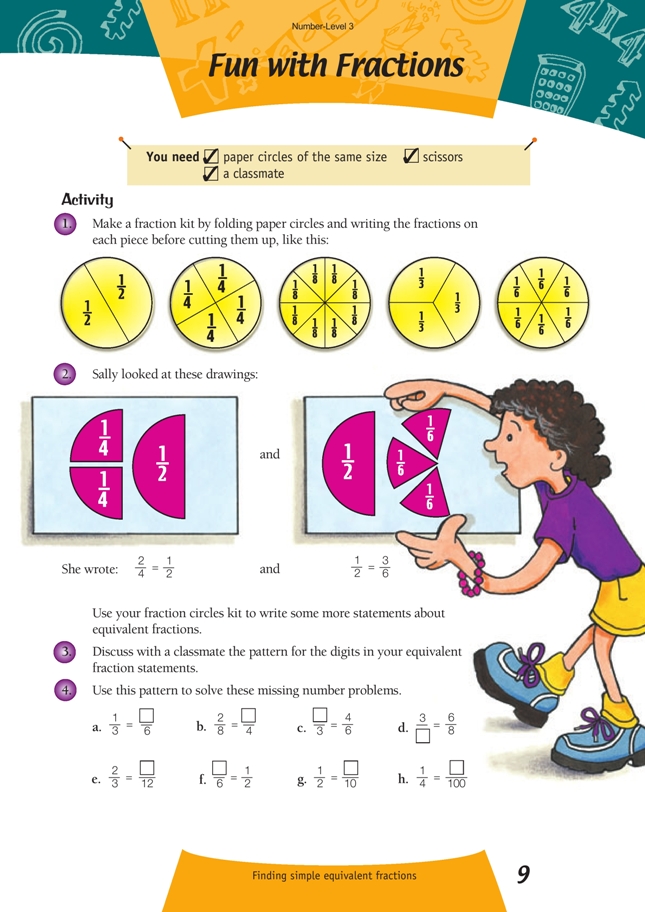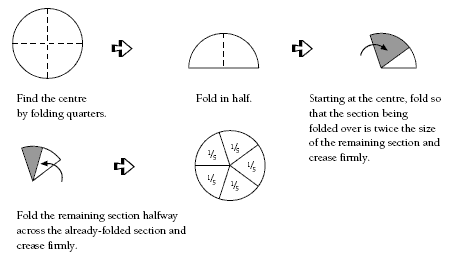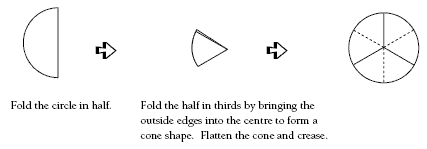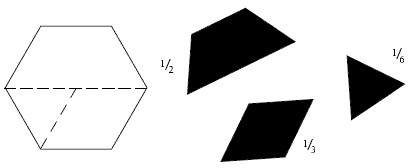This is a level 4 number activity from the Figure It Out series. It relates to Stage 7 of the Number Framework.
A PDF of the student activity is included.
Click on the image to enlarge it. Click again to close. Download PDF (203 KB)
use fraction circles to find equivalent fractions
FIO, Level 3, Number, Book 1, Fun with Fractions, page 9
Scissors
Classmate
This activity will help students find simple equivalent fractions.
An efficient way to cut out paper circles is to:
Note: You will still need to hold the edges of all your pieces of paper as you cut around your circle shape to stop the bottom pieces slipping out of line.
Folding the circles into quarters is straightforward, but students will have to estimate their folds for thirds and also for fifths, if you wish to extend the activity to include fifths. For example, for fifths:
Thirds can be folded as follows:
To understand fraction notation, students need to keep in mind the unit of which the fraction is a part. In question 1, the unit is the whole circle. Use language that shows the meaning of the fraction notation. Half of a circle can be described as “one of the two pieces that make the whole circle” and three-quarters as “three out of the four quarters that make the whole circle”. This focus will help students see that the numerator tells them how many pieces they have, while the denominator tells them how many pieces the whole unit is divided into.
An interesting, open-ended starter question is “Can a quarter be bigger than a half?” Encourage students to justify either a positive or a negative response, for example, “A quarter of an elephant is always bigger than half a flea.” “A quarter of this apple is always smaller than a half of this same apple.”
You could then ask the students “So how do you know how big a fraction is?” They should realise that this depends on how big the whole unit is. This shows the importance of both the numerator and the denominator working together to describe the fraction.
When students are looking at the pattern of their digits in question 3, check to see whether they have mistaken their equivalent fraction pattern for a sequential pattern.
If students focus on the numerator and denominator as separate entities, they may think of the numbers as increasing in size. They need to see that the fraction has not changed, but the unit has broken into more and more parts.
Use other shapes besides a circle. A rectangle is a good shape to use to show halves, quarters, and eighths because it has four sides. Hexagons are excellent for showing halves, thirds, and sixths because they have six sides. Pattern blocks are very good hands-on equipment for showing equivalent fractions based on the hexagon.
Answers to Activity
1. Practical activity
2. Answers will vary. They could include 2/8 = 1/4 , 2/6 = 1/3 , and 4/8 = 1/2 .
3. Answers will vary. Patterns will probably be based on multiples.
4. a. 1/3 = 2/6
b. 2/8 = 1/4
c. 2/3 = 4/6
d. 3/4 = 6/8
e. 2/3 = 8/12
f. 3/6 = 1/2
g. 1/2 = 5/10
h. 1/4 = 25/100




